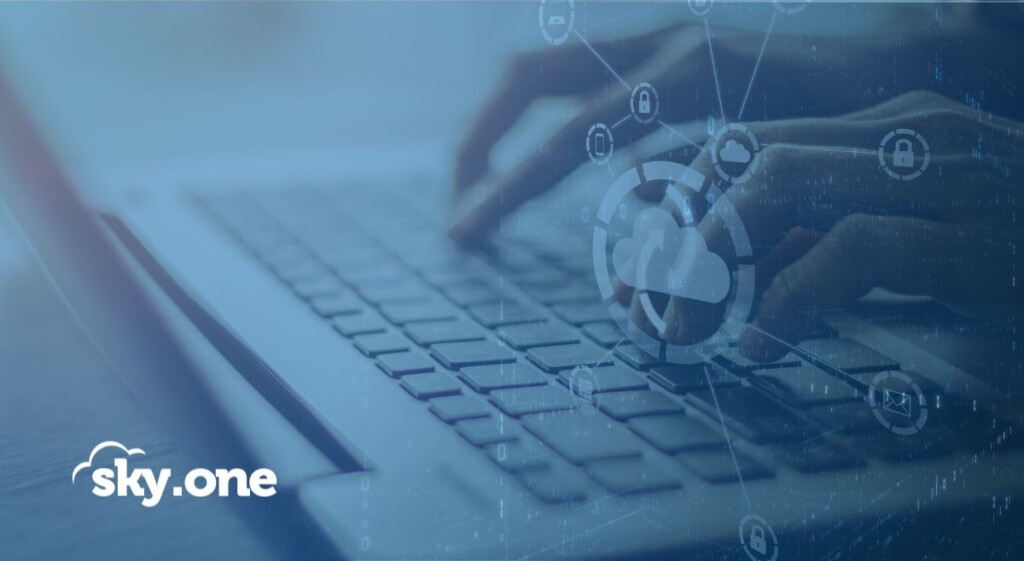Today, information security emerges as an unquestionable priority for companies seeking to protect their sensitive data and maintain the trust of their customers.
According to the report “Cyber security trends 2023: The latest threats and risk mitigation best practice – before, during and after a hack” , the number of cases in which data leaks occur is increasing every year: it doubled from 40% in 2019 to almost 80% in 2022, with a significantly higher 2023.
Given this scenario, Pentest , or penetration testing , emerges as an important tool in cyber defense, playing its role in identifying and correcting vulnerabilities before cybercriminals can exploit them.
Therefore, during this article, we will understand Pentest in more depth, offering a comprehensive view of what it is , how it works, when and why your company should consider implementing this practice.
Find out how to strengthen, once and for all, the foundations of digital security in your organization!
What is Pentest?
Pentest (short for penetration testing) is an essential practice where experts simulate attacks on information systems to identify vulnerabilities. The goal is to find and fix flaws before malicious individuals can exploit them.
Thus, the Pentest methodology can involve several steps, starting with defining the scope and continuing through the phases of recognition, gaining access, maintaining access and analyzing results. It is through this in-depth assessment that companies can strengthen their defenses against real threats.
Carrying out a penetration test employs a series of specific tools. It is possible to include vulnerability scanners cracking , intrusion testing frameworks simulating attacks of different types and complexities.
Therefore, the weaknesses that can be discovered with Pentests range from inadequate configurations to software failures software hardware problems . By identifying these weaknesses, companies can take corrective actions to mitigate risks, ensuring a much more secure IT infrastructure.

Why is cybersecurity so important for companies?
As we saw at the beginning of this article, the number of cyber attacks only increases over the years. attacks , for example, grew by 50% during the first half of 2023.
Therefore, cybersecurity has become an essential pillar for companies of all sizes due to the danger that digital threats pose worldwide.
Therefore, confidential information, such as customer data and intellectual property, are valuable assets that require robust protection against unauthorized access. Additionally, cyberattacks can disrupt daily operations, causing significant financial losses.
The consequences of an attack are severe: a data breach can damage customer trust and the public image , resulting in lost business and legal problems.
In this way, cybersecurity professionals have the role of creating and maintaining a robust organizational security structure that considers all areas of the business. They must be responsible for:
- Identify and correct vulnerabilities in the network;
- Implement security protocols ;
- Conduct monitoring to detect suspicious behavior.
For businesses, a solid cybersecurity strategy is less of an option and more of a necessity , and is crucial to protecting both your interests and those of your customers. And Pentest is an excellent tool to build it.
What types of Pentest exist?
Today, there are three main types of Pentests, each offering different levels of analysis and context during the security assessment. Check out each of them below:
black box
black box Pentesting , the tester has little or no prior knowledge about the target systems. They mimic an external attacker performing the exploit without inside information, which provides a realistic perspective on what an attacker could discover and exploit.
white box
Unlike black box white box Pentest is carried out with complete knowledge of the infrastructure to be tested. It is essentially a detailed internal security audit where the tester has access to network diagrams, source codes and other relevant information. Therefore, this testing typically results in a more in-depth vulnerability assessment.
gray box
The gray box intermediate approach that provides the tester with partial knowledge of the system, simulating an attack by someone who has some level of access or internal knowledge. This type of testing helps evaluate how well a system withstands insider attacks.
The main Pentest methodologies
Before starting a penetration test, it is crucial to understand the methodologies involved in this process. They guide testers through the recognition process, define the scope of testing, and ensure that all aspects of the web are examined according to established standards.
Check out some of the existing methodologies:
OWASP Testing Guide
The OWASP Testing Guide is a comprehensive resource that provides a series of tools and techniques web application security . It details a four-phase testing process and covers everything from planning and preparation to information gathering and vulnerability testing. It is an essential reference for professionals who perform Pentests on web .
NIST SP 800-115
Known as the “Technical Guide to Information Security Testing and Assessment” government approach to Pentest. Emphasizes meticulous planning and documentation and recommends procedures for identifying vulnerabilities in systems. It includes methods for testing the effectiveness of security measures and is often used in conjunction with other standards for compliance testing.
PTES (Penetration Testing Execution Standard)
PTES provides a standard framework for carrying out Pentests, providing guidance on defining scope and procedures. This standard helps ensure that all Pentests are performed with a level of rigor and consistency, covering steps ranging from pre-engagement to final reporting. It promotes a clear understanding of what is being tested and why, which is essential to delivering effective test results.
What is the difference between Pentest and vulnerability analysis?
Pentest and vulnerability analysis are two fundamental approaches to information security. However, they have different objectives within the context of evaluating and strengthening the IT infrastructure.
See the main differences between them in the table below:
| Vulnerability analysis | Pentest | |
| Main focus | Identification of weaknesses in systems and networks | Attack simulation to identify and exploit vulnerabilities |
| Methodology | Automated, using specific software | Combination of automated and manual techniques, requiring advanced skills |
| Depth | Superficial, as it does not actively exploit the vulnerabilities found | Intensive and detailed, involving the execution of controlled attacks for testing |
A vulnerability analysis serves as an initial step to understanding possible security flaws, while Pentest aims to evaluate the effectiveness of existing security measures, allowing a more realistic assessment of a system's resistance against real attacks.
In short, vulnerability analysis is intended to find flaws; Pentest seeks to explore them , ethically, to understand the real implications of a potential breach.
How do you know when is the right time to perform a Pentest?
In the world of information security, carrying out a penetration test is essential to understanding an organization's resilience to attacks. Therefore, determining the appropriate time to perform a Pentest depends on several factors, including:
After significant infrastructure changes
It is prudent to perform a Pentest when there are changes to the IT environment, such as the implementation of new systems or important updates.
Before launching applications or systems
Ensuring that new applications are secure before their release to the public is critical.
After security incidents
If the company has suffered a security incident, a subsequent Pentest may identify other possible vulnerabilities not previously explored.
Regulatory compliance
Many standards and regulations require periodic penetration testing to maintain compliance.
For most organizations, it is recommended that Pentest be performed at least annually . However, companies in highly regulated industries or with a lot of online may need a higher frequency.
How a Pentest works: the phases of a system penetration test
Pentest's structured process involves a series of phases that range from planning to executing controlled attacks to identify vulnerabilities.
Check out how they work in practice:
Identification and planning
At the beginning of a Pentest, the identification and planning phase is essential to establish the scope and objectives of the test. This includes defining which systems will be tested and which methods will be used, which are essential for effective planning.
Information collection
Information gathering is the step that precedes actual attacks. It involves intensive reconnaissance , looking for public data that can help identify entry points into the system. Vulnerability scanning tools can be used to automate part of this process.
Vulnerability detection
This is the phase that involves using tools and techniques to find flaws that can be exploited. Thus, it is the step that makes it possible to create a map of the security flaws existing in the system under test.
Vulnerability Exploitation
During the vulnerability exploration phase, experts try to exploit flaws found in the previous step. Vulnerabilities such as SQL injection are tested and, if the exploitation is successful, the perpetrator may gain unauthorized access to the system.
Data analysis and reporting
After the exploitation attempts, data analysis and reporting begins, compiling the results and elaborating details on the discovered vulnerabilities. Communication is key; therefore, the report needs to be clear and objective, providing recommendations for mitigating the identified risks.
What are the post-Pentest recommendations? What to do?
After carrying out a Pentest, some measures are essential to ensure that the company's information security is reinforced. Check out the recommendations:
- Detailed analysis of the report: it is essential that the IT team meticulously analyze the results presented, understanding the vulnerabilities discovered;
- Vulnerability prioritization: Not all weaknesses have the same level of risk.
It is necessary to prioritize the correction based on the potential damage that each one can cause; - Weakness management: keeping a record of vulnerabilities and continuously monitoring them allows the organization to proactively manage weaknesses;
- Remediation plan: an action plan must be drawn up to remedy the identified flaws. Actions may include software and configuration updates;
- Employee training: after the Pentest, it is necessary to educate the team about the best security practices that will be adopted;
- Verification tests: after implementing the corrections, it is recommended to run new tests to ensure that the measures were effective.
- Review of security policies: if necessary, review and update internal security policies to prevent future vulnerabilities.
In this way, it is possible to strengthen the business security posture against cyber attacks, ensuring that flaws found in Pentest are appropriately managed and corrected .
What are the advantages of Pentest for companies?
As we have seen so far, Pentest not only allows the identification and resolution of vulnerabilities, but also strengthens the security posture in the face of constant threats.
Now, let’s look at some of the main advantages of this tool for companies:
Proactive vulnerability identification
Pentest enables the active detection of security flaws, allowing the company to anticipate external attacks. This analysis is critical as it reveals weaknesses before they are exploited by third parties.
Security posture assessment
Through Pentest, companies obtain an accurate diagnosis of how their defenses react to different attack strategies, guiding strategic security planning.
Risk mitigation
The information obtained with Pentest guides the development of effective risk mitigation solutions, thus reducing the chances of security incidents that could impact the company.
Compliance with regulations
Many industries require compliance with safety standards. Therefore, companies that carry out Pentests demonstrate commitment to meeting these requirements, avoiding penalties.
Security team training
Pentest also serves as a training tool, educating the security team on where to focus their efforts and how to react to real threats.
Long-term cost savings
Investing in penetration testing can mean financial savings in the long term, avoiding expenses with security incidents, system damage and data loss.
Protection of business reputation
Carrying out Pentests demonstrates responsibility and care for security, preserving the company's image and avoiding damage to its reputation that could arise through violations.
The importance of Pentest for different market sectors
With digital transformation, carrying out the Pentest has become essential for companies in all market segments, not just technology ones. Furthermore, it is adaptable to the reality of each sector, considering its peculiarities and specific regulations.
See how each area can benefit from it:
Financial sector
Financial institutions are constantly under threat from cyber attacks. Thus, Pentest in this area contributes to protecting financial and customer data, detecting weaknesses before they are exploited.
Health
Health information is extremely sensitive. Rigorous assessment through Pentest ensures the integrity and privacy of patient data, while also complying with strict security regulations.
Education
Universities and schools often store student data and valuable research. Thus, testing helps maintain the security of this data, preventing loss of vital information or unwanted exposure.
E-commerce
continuous online monetary transactions With Pentest, vulnerabilities can be found and fixed, which is crucial to maintaining customer trust and system integrity.
Government and public services
For government bodies, cybersecurity is essential to protect confidential information of the State and citizens. In this way, penetration testing ensures that systems are robust against attacks and information leaks.
Pentest: the main challenges
With the rapid pace of technological innovation and incessant cyber threats, Pentest has adapted .
Professionals in this area face a growing demand for security in the face of new attack methodologies, needing to always stay up to date with the latest cybersecurity trends and challenges.
Below we highlight some important trends:
Evolution of cyber threats
Attack methods are becoming increasingly sophisticated , forcing Pentest professionals to develop advanced techniques to identify vulnerabilities.
Thus, the complexity of the code and the diversity of platforms expand the spectrum of failure points, requiring comprehensive training and constant adaptation.
Pentest in cloud environments
Migrating to the cloud environment introduces unique cybersecurity challenges. Vulnerability assessment in this context must consider infrastructure configuration, access control and data separation.
Given this scenario, protection in cloud environments requires an integrated vision that combines traditional pen testing and specialized knowledge in cloud security .
IoT and cybersecurity
With the expansion of the number of devices connected through the Internet of Things (IoT) , new points of attack are added to the network.
Thus, each device representing a potential attack vector amplifies the need for robust, IoT-specific penetration testing, as well as awareness that security must be addressed throughout the life of the device.
What to expect from the future of Pentest?
As dictated by the main global trend, the future of Pentest will certainly include technological advances and the adoption of artificial intelligence to improve the effectiveness of security practices.
Check out:
Technological innovations in cybersecurity
Cybersecurity professionals are increasingly adopting innovative tools and advanced technologies to strengthen their Pentest strategies.
automation are expected to perform more efficient and accurate vulnerability analysis. These innovations will make it possible to identify and exploit vulnerabilities that may currently go unnoticed during penetration testing. The main trends in this regard are:
- Advanced reconnaissance capabilities;
- Automation in identifying security flaws;
- More adaptive and contextual planning and testing initiatives.
Artificial intelligence and machine learning
The use of artificial intelligence (AI) and machine learning is revolutionizing the way Pentests are conducted. These technologies not only allow for the simulation of more complex cyberattacks, but also provide in-depth, detailed analysis that is essential for a comprehensive Pentest report. The main trends in this regard are:
- Machine learning in the prediction and analysis of malicious behaviors;
- Continuous improvement of the Pentest process through automatic learning and adaptation;
- Increased ability of security professionals to interpret data and respond to threats.
3 statistics that prove the importance of Pentest
Data increasingly highlights the critical importance of Pentests as an essential layer of defense against sophisticated threats in the digital world. See below three valuable statistics that illustrate the importance of this process for networks and web applications:
- A study by the Ponemon Institute indicates that the average cost of a data breach is approximately $3.86 million .
Penetration tests help companies identify and remedy vulnerabilities before they are exploited, minimizing significant financial losses; - Reports show that 43% of cyber attacks target web .
Regularly carrying out Pentests allows companies to detect security flaws in application development, strengthening network security and reducing the chances of successful attacks; - Also according to the Ponemon Institute, companies take, on average, 280 days to find the source of a data breach following a cybersecurity issue.
Therefore, systematic Pentests are essential to identify these flaws from the beginning, ensuring that applications remain protected from deployment.
Skyone: your Pentest with a highly specialized team
After all this information, the question remains: is your business's digital environment really safe? Stay one step ahead of attackers by patching vulnerabilities and mitigating risks!
Skyone Pentest , also known as Penetration Testing, is based on a deep understanding of attack techniques, known and unknown vulnerabilities, and how cybercriminals can exploit them.
proactively check whether there are loopholes to access your confidential information, the possibility of denial of services, data hijacking for the purpose of ransom demands and much more.
Find out more about our platform!
Conclusion
Conducting a Pentest is a crucial step in strengthening cybersecurity. It allows the identification and remediation of vulnerabilities, acting as a catalyst for the continuous improvement of a business' defense strategies.
Today, attacks are increasingly sophisticated, generating millions in losses for companies around the world. One of them is ransomware – an attack that many organization leaders still have doubts about the impacts and how to combat.
Take advantage and check out our special article on this subject!





